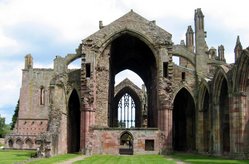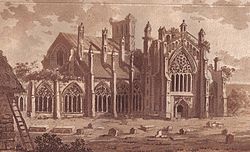- Melrose Abbey
-
Melrose Abbey 
Monastery information Order Cistercian Established 1136 Disestablished 1609 Mother house Rievaulx Abbey Diocese Diocese of Glasgow Controlled churches Cavers Magna; Dunscore; Ettrick; Hassendean; Mauchline; Melrose; Ochiltree; Tarbolton; Westerkirk; Wilton People Founder(s) David I of Scotland Important associated figures Waltheof, Jocelin Site Location Melrose, Scottish Borders Melrose Abbey is a Gothic-style abbey in Melrose, Scotland. It was founded in 1136 by Cistercian monks, on the request of King David I of Scotland. It was headed by the Abbot or Commendator of Melrose. Today the abbey is maintained by Historic Scotland (open all year; entrance charge). The ruins of Melrose are widely considered among the most beautiful of religious houses in the United Kingdom, being especially notable for a wealth of well-preserved figure-sculpture, and its architecture is considered to be some of the finest in Scotland.[1]
The east end of the abbey was completed in 1146. Other buildings in the complex were added over the next 50 years. The abbey was built in the form of a St. John's cross. A considerable portion of the abbey is now in ruins, though a structure dating from 1590 is maintained as a museum open to the public.
Alexander II and other Scottish kings and nobles are buried at the abbey. The embalmed heart of Robert the Bruce is also said to rest on the abbey's grounds, while the rest of his body is buried in Dunfermline Abbey. In 1812, a stone coffin that some speculated was that of Michael Scot the philosopher and "wizard", was found in an aisle in the abbey's south chancel.
It is known for its many carved decorative details, including likenesses of saints, dragons, gargoyles and plants. On one of the abbey's stairways is an inscription by John Morow, a master mason, that says: "Be halde to ye hende" (Keep in mind, the end, your salvation), which has become the motto of the town of Melrose.
Contents
History
An earlier monastery dedicated to Saint Aidan[disambiguation needed
 ] was founded at Old Melrose in the 7th century on a site about two miles (3 km) east of Melrose Abbey. It was raided by Kenneth I of Scotland in 839. Set in a bend of the river Tweed, a graveyard marks the site. St. Cuthbert was one of the abbots, before he became bishop of Holy Island, in Northumbria.
] was founded at Old Melrose in the 7th century on a site about two miles (3 km) east of Melrose Abbey. It was raided by Kenneth I of Scotland in 839. Set in a bend of the river Tweed, a graveyard marks the site. St. Cuthbert was one of the abbots, before he became bishop of Holy Island, in Northumbria.King David I wanted the new abbey to be built on the same site, but the Cistercians insisted that the land was not good enough for farming and instead selected the current site. It is supposed to have been built in ten years. The church of the convent was dedicated to St. Mary (like all Cistercian houses) on July 28, 1146. The Abbey became the mother church of the order in Scotland.


Melrose Abbey in 1800 when part of the abbey was still in use as the parish church.[2] A town slowly grew up around the Abbey. In 1322 the town was attacked by the army of Edward II, and much of the Abbey destroyed. It was rebuilt by order of King Robert the Bruce, with Sir James Douglas being principal auditor of finance for the project.[3] The King's embalmed heart, encased in lead, was later buried in the church following its return from crusade with the dead Lord Douglas in 1330/1331.
In 1385 the Abbey was burned by the army of Richard II of England as he forced the army of Robert II of Scotland back to Edinburgh. It was rebuilt over a period of about 100 years—construction was still unfinished when James IV visited in 1504.
In 1544, as English armies raged across Scotland in an effort to force the Scots to allow the infant Mary, Queen of Scots to marry the son of Henry VIII, the Abbey was again badly damaged and was never fully repaired. This led to its decline as a working monastery. The last abbot was James Stuart (illegitimate son of James V), who died in 1559. In 1590, Melrose's last monk died.
The Abbey withstood one final assault—some of its walls still show the marks of cannon-fire after having been bombarded by Oliver Cromwell during the English Civil War.
In 1610, a portion of the Abbey's church was converted into a parish church for the surrounding town. This involved the insertion of a plain vault into the crossing, which obscured the original ribbed vaulting. It was used until 1810 when a new church was erected in the town.
In 1996 an archaeological excavation on the site unearthed a conical lead container and an engraved copper plaque that read "The enclosed leaden casket containing a heart was found beneath Chapter House floor, March 1921, by His Majesty's Office of Works"; the lead container was not opened, but it is assumed that since there are no records of anyone else's heart being buried at Melrose that it was indeed the heart of Robert I. The container was reburied at Melrose Abbey on June 22, 1998. A plinth was unveiled on June 24 that covers the burial site of the container.
Description
The abbey is built in the form of St. John's cross, of the Gothic style of architecture, and is 258 feet (79 m) in length; the breadth 137-1/2 feet; and 943 feet (287 m) in circumference. A considerable part of the principal tower is now in ruins; its present height is 84 feet (26 m). There are many very superb windows; the principal one at the east end (which is the top nave of the cross,) appears to have been more recently built than the others, and is 57 feet (17 m) in extreme height, and 28 feet (8.5 m) wide. It has been ornamented with statues, &c. The beauty of the carved work, with which the abbey is profusely decorated, is seldom equalled.
There are in the external view of the building 50 windows, 4 doors, 54 niches, and above, 50 buttresses. The abbey was much injured by the English in 1322 and 1384. Richard II made it a grant in 1389, as some compensation for the injuries it had sustained in the retreat of his army. It was also greatly defaced by Protestants during the Reformation.
There were 100 monks, without including the abbot and dignitaries. The last abbot was James Stuart, natural son of James V, who died in 1559. The privileges and possessions of the abbey were very extensive, and it was endowed by its founder, David, with the lands of Melrose, Eildon, and other places; the right of fishery on the Tweed; and succeeding monarchs increased its property. In 1542, the revenue of the abbey was, "£1758 in money, 14 chalders nine bolls of wheat, 56 chal. 5 bolls of barley, 78 chal. 13 bolls of meal, 44 chal. 10 bolls of oats, 84 capons, 620 poultry, 105 stone of butter, 8 chal. of salt, 340 loads of peats, and 500 carriages;" besides 60 bolls of corn, 300 barrels (48 m3) of ale, and 18 hogsheads of wine, for the service of the mass: a large quantity for the entertainment of strangers; £4,000 for the care of the sick; and £400 to the barber. These were given up at the commencement of the reformation in 1561. The lands were either seized by the crown, or divided amongst the nobles. A large portion fell into the hands of the Scotts of Buccleuch.
Burials
- Jocelin (Bishop of Glasgow)
- Waltheof of Melrose
- William de Bondington - Bishop of Glasgow
- William Douglas, 1st Earl of Douglas
- James Douglas, 2nd Earl of Douglas
Tributes
Sir Walter Scott described Melrose Abbey in one of his poems[1], The Lay of the Last Minstrel, Canto Second.[4]
A Presbyterian congregation in Bloomfield Hills, Michigan, USA has built what may be the last Gothic cathedral in the U.S. and patterned it after Melrose Abbey. The church, Kirk in the Hills, completed in 1958, majestic in its Gothic style, is located on a 40-acre (160,000 m2) lakeside setting 20 miles (32 km) north of Detroit.[5]
See also
- Abbot of Melrose, for a list of abbots and commendators
- List of religious houses in Scotland
- Borders Abbeys Way
- List of places in the Scottish Borders
- List of places in Scotland
References
- ^ a b Dunton, Larkin (1896). The World and Its People. Silver, Burdett. p. 66.
- ^ Stoddart, John (1801), Remarks on Scenery and Manners in Scotland. Pub. William Miller, London. Facing P. 277.
- ^ 26th March 1325-The Records of the Parliaments of Scotland to 1707 ([www.rps.ac.uk]), K.M. Brown et al eds (St Andrews, 2007-2011).
- ^ Scott, Sir Walter. "The Lay of the Last Minstrel, Canto Second". http://www.theotherpages.org/poems/canto02.html.
- ^ Kirkinthehills.org
External links
- Melrose Abbey - site information from Historic Scotland
 "Abbey of Melrose". Catholic Encyclopedia. New York: Robert Appleton Company. 1913.
"Abbey of Melrose". Catholic Encyclopedia. New York: Robert Appleton Company. 1913.- Melrose Abbey and its Sculptures
- Melrose Abbey from aboutscotland.com
- The Mirror of Literature, Amusement, and Instruction, No. 290, Saturday, December 29, 1827, available from Project Gutenberg
Coordinates: 55°35′56″N 2°43′4″W / 55.59889°N 2.71778°W
Melrose filiation (from Rievaulx) Melrose Abbey (1136) • Newbattle Abbey (1140) • Holmcultram Abbey* (1150) • Kinloss Abbey (1150) • Coupar Angus Abbey (1164) • Balmerino Abbey (1227)Dundrennan filiation (from Rievaulx) Mellifont filiation** (from Cîteaux) Kinloss filiation**** (from Rievaulx) Latter day foundations Nunraw (1946)* Now in England, but at the time of its foundation, part of the Scottish kingdom of David I.
** Filiation from Mellifont Abbey in Ireland, founded 1142.
*** If this existed, it was shortly afterwards replaced by a Premonstratensian establishment.
**** In the line of filiation from Melrose (above).Categories:- Historic Scotland properties
- Ruins in Scotland
- Listed buildings in the Scottish Borders
- Category A listed buildings in Scotland
- Listed monasteries in Scotland
- Christianity in medieval Scotland
- Cistercian monasteries in Scotland
- Scheduled Ancient Monuments in Scotland
- Wars of Scottish Independence
- 1130s architecture
- Religious organizations established in 1136
- Christian monasteries established in the 12th century
- 1609 disestablishments
- Museums in the Scottish Borders
- Religious museums in the United Kingdom
Wikimedia Foundation. 2010.




